In this post, we will use a survey sent to 213 part-time and full-time freelance writers to determine the average freelance writing rates. Using that data, we’ll answer a question we’ve heard quite a bit in the industry.
What should I charge?
Of course, a new writer isn’t going to charge $1,000+ per article after one day. Writing rates are meaningless if you can’t provide the client value and ultimately drive leads and revenue for them.
And every writer is different in terms of (1) how quickly they can write, (2) pricing models, and (3) business goals.
So, in this review, we’ll use the new data gathered, plus our experience doing freelance writing for enterprise clients and other companies, to give you the insights you need to:
- Charge competitive rates that make the most sense for your freelance business
- Get the most out of your marketing efforts by targeting the right channels for leads
This a big post, so here’s a snippet of the patterns that emerged when we poured through the data:
What’s a fair freelance writing rate?
- $250 to $399 is the most popular rate for a 1,500 word blog post.
- $500 to $999 is the most popular rate for writing a whitepaper.
- The most popular pricing model is per project.
Key findings 💡
🙌 All freelancers earning over $100K have been writing for 2+ years.
👻 Most writers don’t charge extra for ghostwriting. Of those who do, the majority charge a premium of between 16% and 20%.
💰 Word-of-mouth referrals are the biggest sources of high-paying freelance writing gigs.
Methodology
In this edition of Peak Freelance’s annual Freelance Writing Rates report, we surveyed 213 freelance writers to gain perspective on what they charge for writing services.
Writers ranged from newbies (less than a year) to industry vets with over 11 years of experience. We asked questions around finding high-paying gigs, scope creep, and displaying rates on websites.
We encourage you to share the text, data, and graphics in this report. Please cite and link back to the original.
Thoughts from our founders
We sat down with Michael Keenan and Elise Dopson, the founders of Peak Freelance, to get their reaction to the data and see what it means for freelancers in the year ahead.
Michael:
- The amount of ecommerce writers surveyed was surprisingly low! I think we’ll see more writers specialize in ecommerce in coming years as brands establish their digital presence. They’ll need resources and education to market to consumers online, and freelance content writers can help them improve SEO, produce high-converting landing pages, and more.
- Average freelance writing income was at a lower rate than I expected. There is room for improvement and resource development to help writers build their skill sets, provide more value, and charge more. Community and education will be a strong theme in 2022.
- I was shocked that most writers aren’t charging more for ghostwriting services. I’ve always felt if you aren’t getting the byline, you should charge a premium for your work. A good reminder for everyone as we move into a new year!
Elise:
- I was surprised to see how experience impacts the rates freelancers charge. This likely boils down to a few things: testimonials and results to back up your work, and the confidence to charge higher rates. Beginner’s charged very low rates and found clients on content mills like Upwork.
- Whitepapers are massively undercharged for. This format has huge revenue potential for clients; they easily see how much money (or leads) they’ve collected off the back of it, which is often in the thousands. Writers: charge a reasonable rate!
- One in five six-figure writers find high-paying writing gigs through communities. I totally identify with that… hence the creation of Peak Freelance 😉
The state of freelance writing in 2022
Freelance writers have been important business assets for years. When COVID-19 emerged and businesses and consumers moved online, freelance writers and content marketers became even more in demand.
To understand how many freelancers arose through a pandemic, 16% of freelancers started less than a year ago as of November 2021. Some 19% reported freelancing for between one and two years. Though the majority of freelancers (65%) have been writing professionally for between two and 10 years.
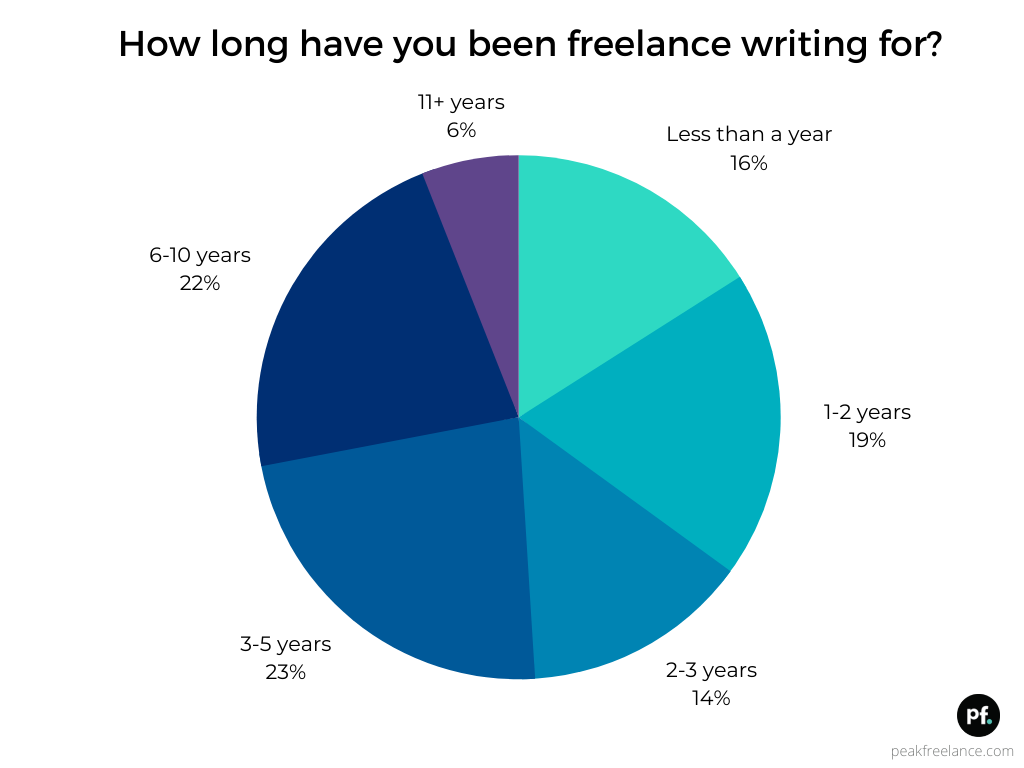
When we dove into freelance writing niches, one industry was more popular than others.
Some 27% reported working in software (SaaS). Another 14% wrote for agencies, and 12% wrote for ecommerce.
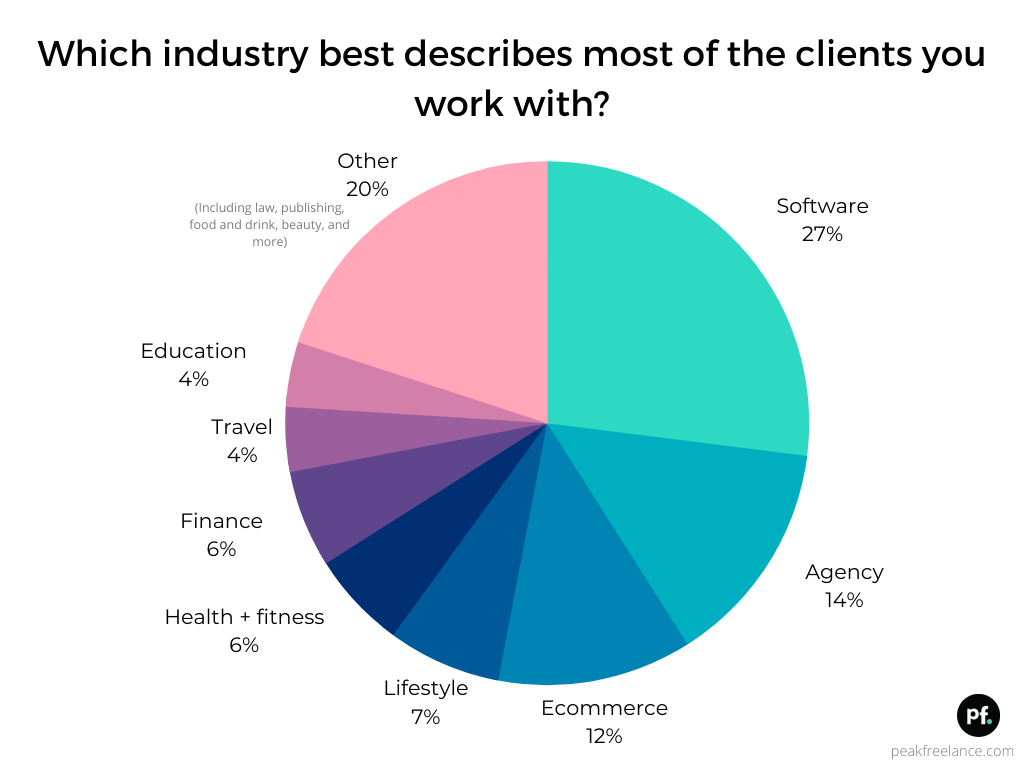
Understanding what niches writers work in leads us to the next section. We wanted to know how much people were changing. So, we asked freelance writers to disclose their yearly earnings.
More than half of freelance writers earn less than $30K per year 💔
The next income level was $31K and $50K, with 18% of freelance writers claiming that was their annual freelance income for 2020. When you combine the percentages of these two groups, almost three quarters of freelance writers make less than $50K per year.
That suggests there is room for business improvement in a majority of freelance writer’s businesses. Think about your own operations. Where can you provide more value for clients to charge more?
Of the remaining writers in the survey, 9% said they made six figures. Some 5% reported making between $100K and $125K, and 4% earned over $125K in 2020.
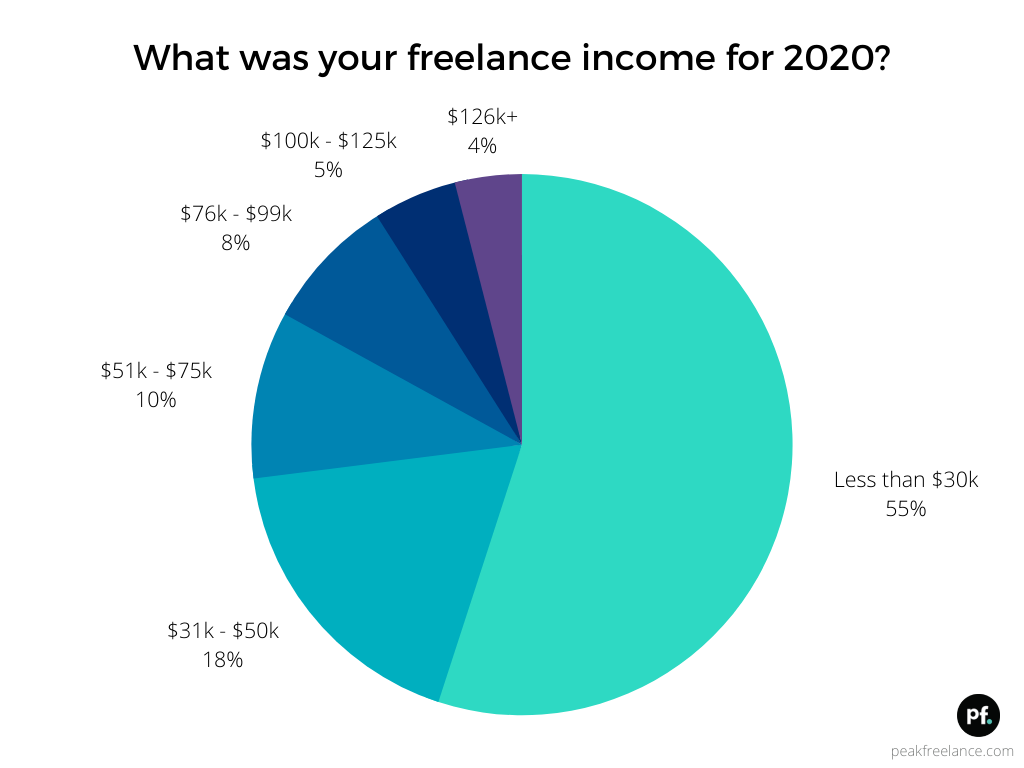
When it comes to time spent versus income as a freelance writer, the longer you’ve been around, the more you earn.
It’s probably no surprise that people bringing in larger incomes have been in business for longer. If we look at those who’ve been freelance writing for less than a year, the vast majority (91%) earn less than $30K.
To reach the six-figure salaries, it seems you need to have been working on your business and growing it for at least a couple of years. Of those earning over $100K, all have been freelance writing for at least two years, with 65% writing for more than six years.
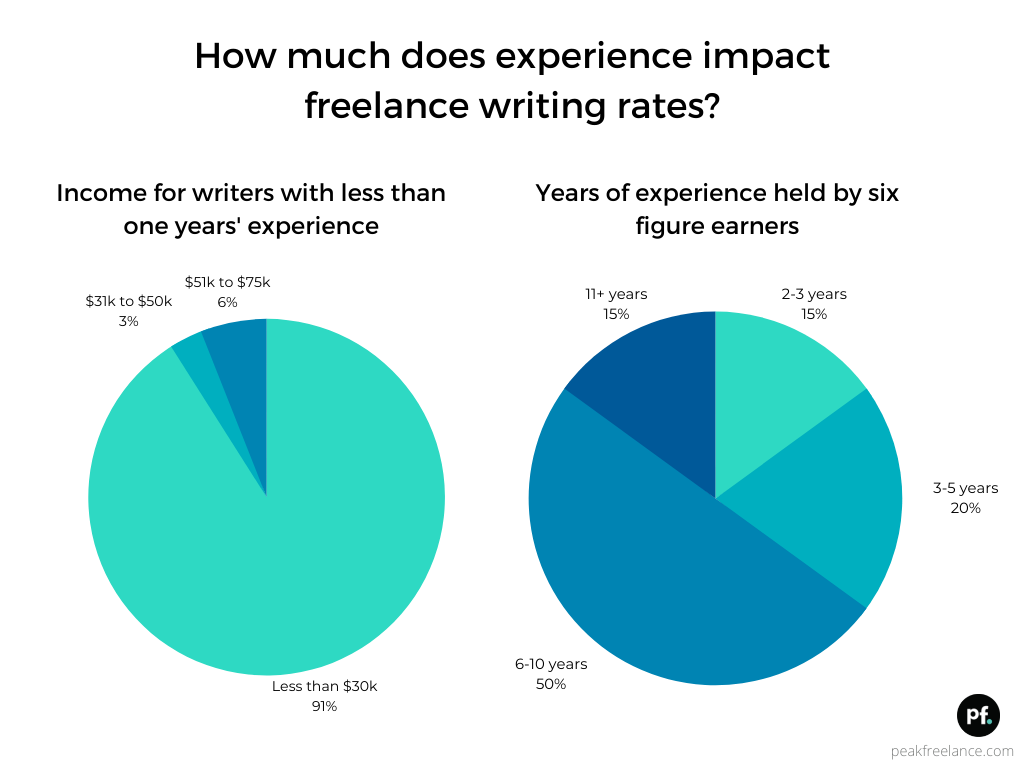
💰 Read about how Peak Freelance’s very own Elise Dopson grew her freelance writing business to six figures over three years.
How much should freelance writers charge?
As noted earlier, the majority of freelancers earn less than $50K, with a small percentage of writers making over $100K per year. Because of this, we wanted to know what price writers charge for different services.
The average freelance writer charges $250-399 for a blog post
Blog posts are one of the most popular freelance writing services, with the vast majority (98%) offering it to clients. A brand’s desire for regular content and a strong presence in the search engine results page means they tap into freelance writing talent to produce blog content.
So, what do freelancers charge for blog posts?
Between $250 and $399 was the most popular response, with 27% of respondents saying this is what they’d charge for a 1,500 word blog post. Just 8% charge four figures or more.
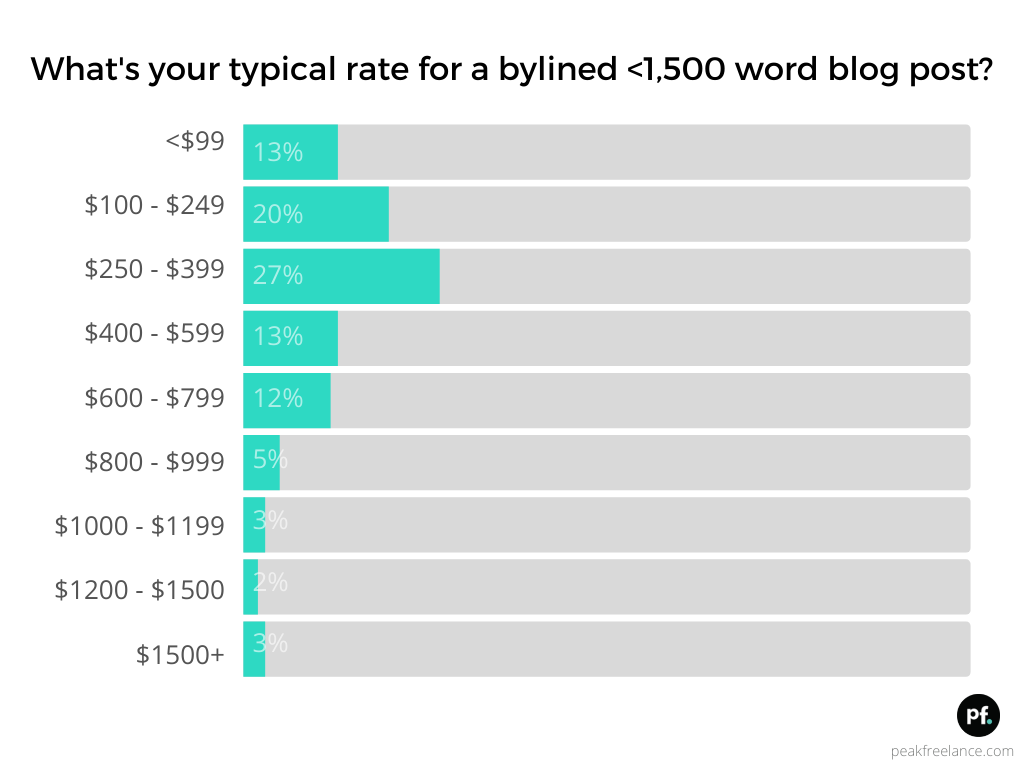
How much you charge per blog post impacts your overall earnings. Of writers that break the six-figure yearly income mark, half charge at least $1,000 per blog post. A quarter demands more than $1,500 for a single 1,500 word article.
Just 10% of six-figure freelance writers charge less than $399 for a blog post.
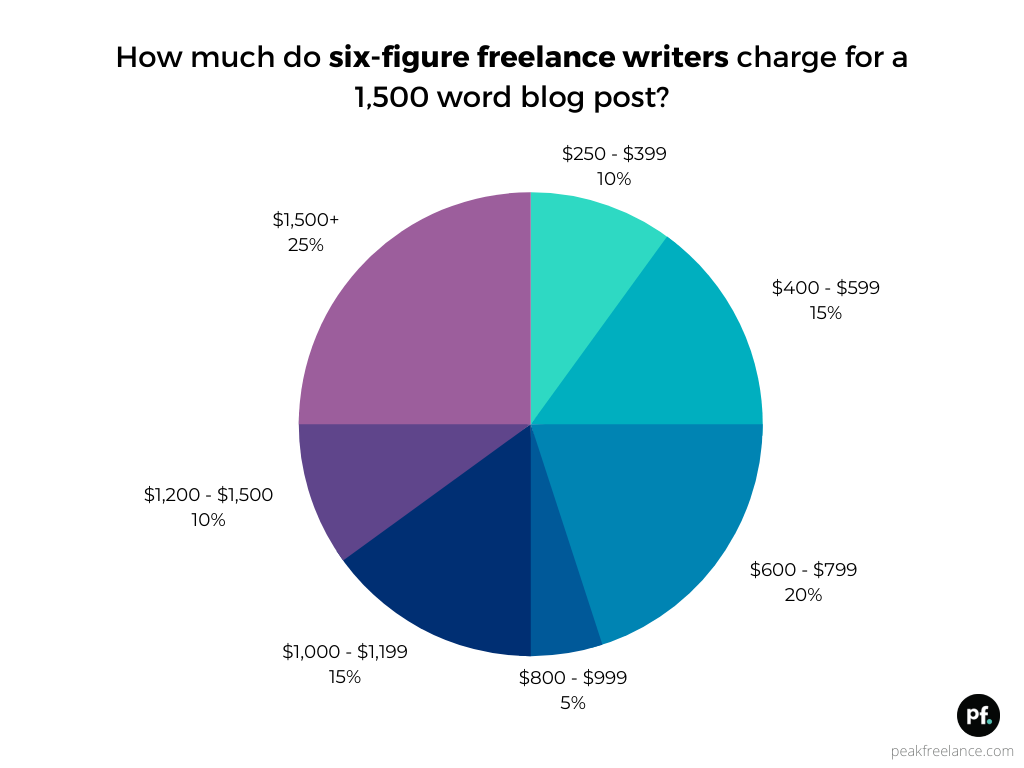
The average freelance writer charges $500-999 for a whitepaper
Whitepapers are longer than blog posts. Brands typically use them to attract leads, especially if the whitepaper is gated (hidden behind an email capture form).
Almost half of the writers in our survey offer whitepaper writing services to clients.
The most popular rate was between $500 and $999, with almost three in 10 respondents claiming that to be their whitepaper writing rate.
However, 55% charge more than $1,000 per whitepaper. Some 17% charged more than $3,000.
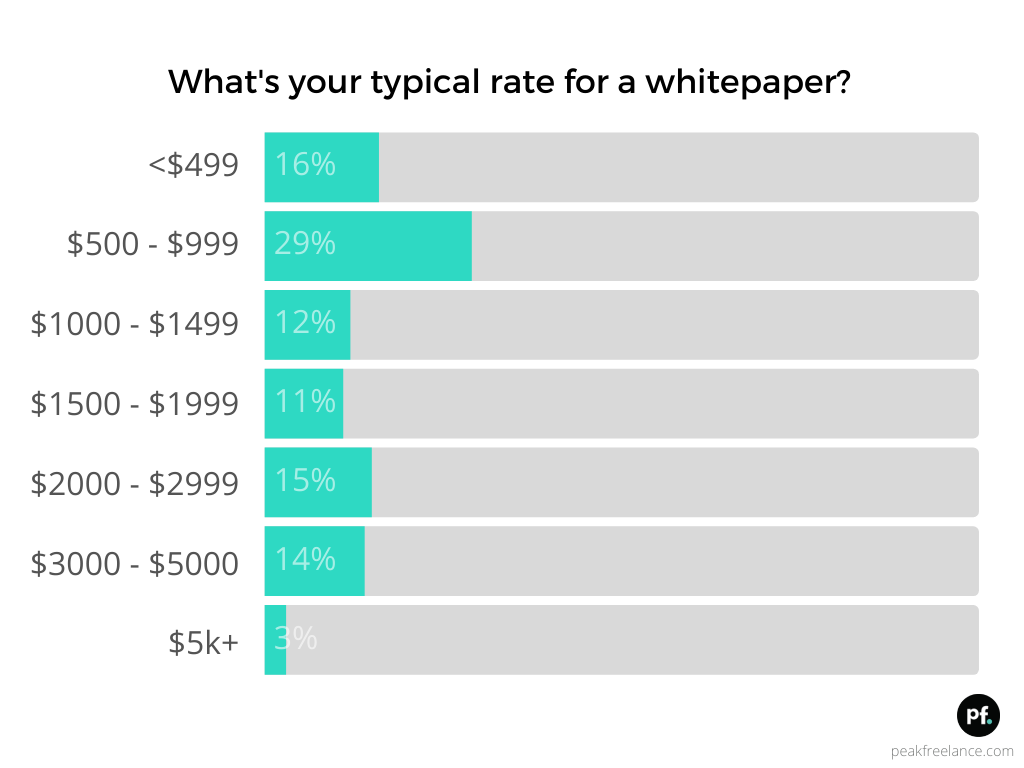
An interesting trend we noticed was that more experienced writers take on whitepaper assignments.
Some 60% of writers with six or more years under their belt take on whitepapers, compared to 44% of writers with less than that.

The average freelance writer charges $99-$249 for an email
Email writing is another popular service that freelancers offer. Half of surveyed writers produce this type of content for clients.
As the graph below shows, 39% charge less than $99 for an email, followed by 32% charging between $100 and $249.
For writers that don’t specialize in email copywriting, this seems to be a lower-priced service, with only 4% charging more than $600 per email.
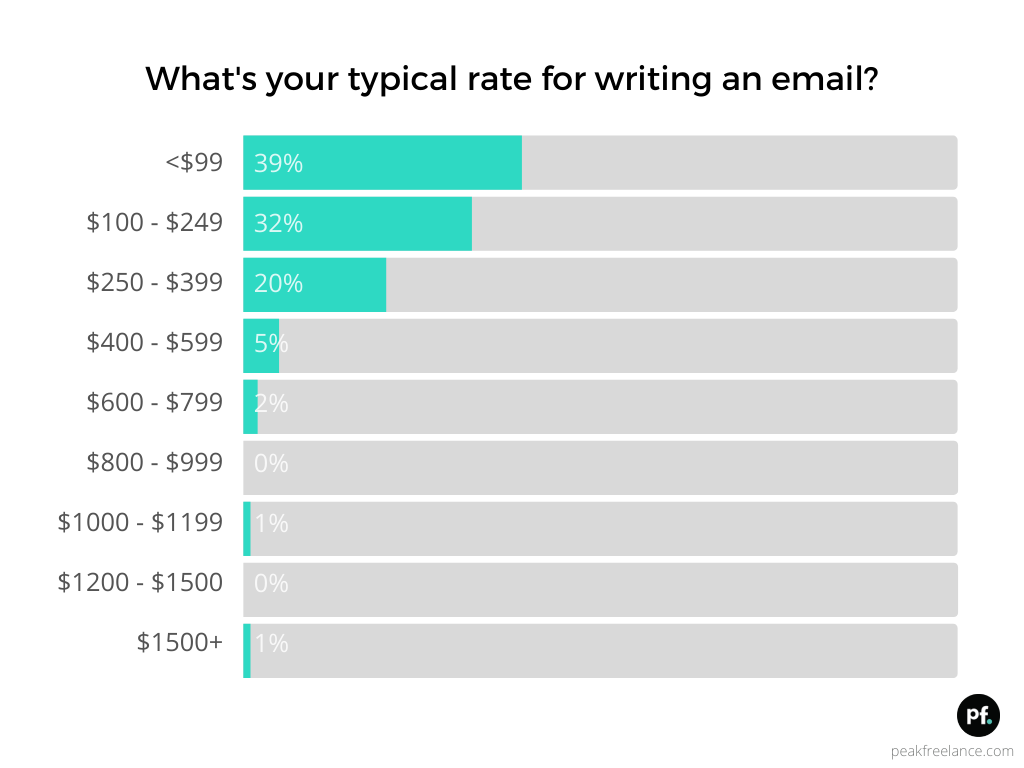
The average freelance writer charges 16-20% extra for ghostwriting
A freelance ghostwriter offers content writing services to clients. The only difference is their name isn’t attached to the piece when published.
Out of the freelance writers we surveyed, the majority (83%) take on ghostwriting work.
Interestingly, just 36% of those writers charge an additional fee if their name is scrapped from the published piece. Of those who do charge extra, almost half whack on at least a 16% premium to their ghostwriting project rate.
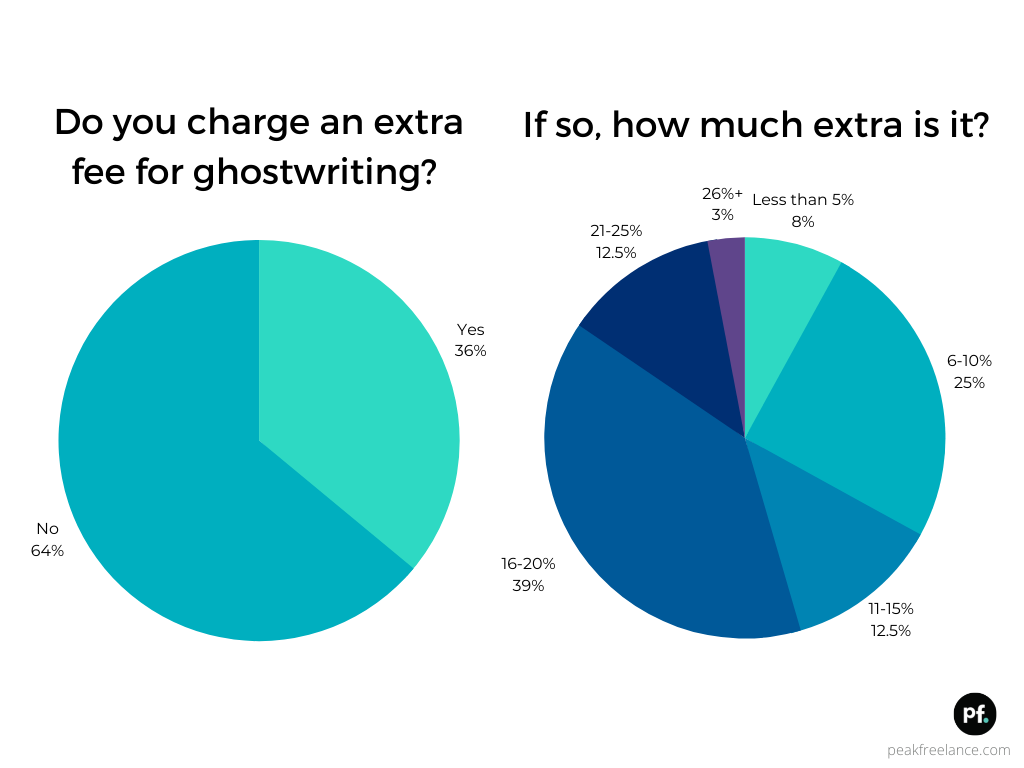
How to choose a pricing model
To set a freelance writing rate, you need a pricing model—the method you use to develop a figure for the client.
The most popular pricing model is a flat fee per project, with 63% opting for this method when pricing freelance projects. They give the client a figure based on the project scope, rather than the minor details (like word count or hours of their time).
However, per word rates comes in as second most popular. Around one in five writers prefer to charge per word; some 11% bill an hourly rate for time spent on the project. A very small number by revenue share (1%).
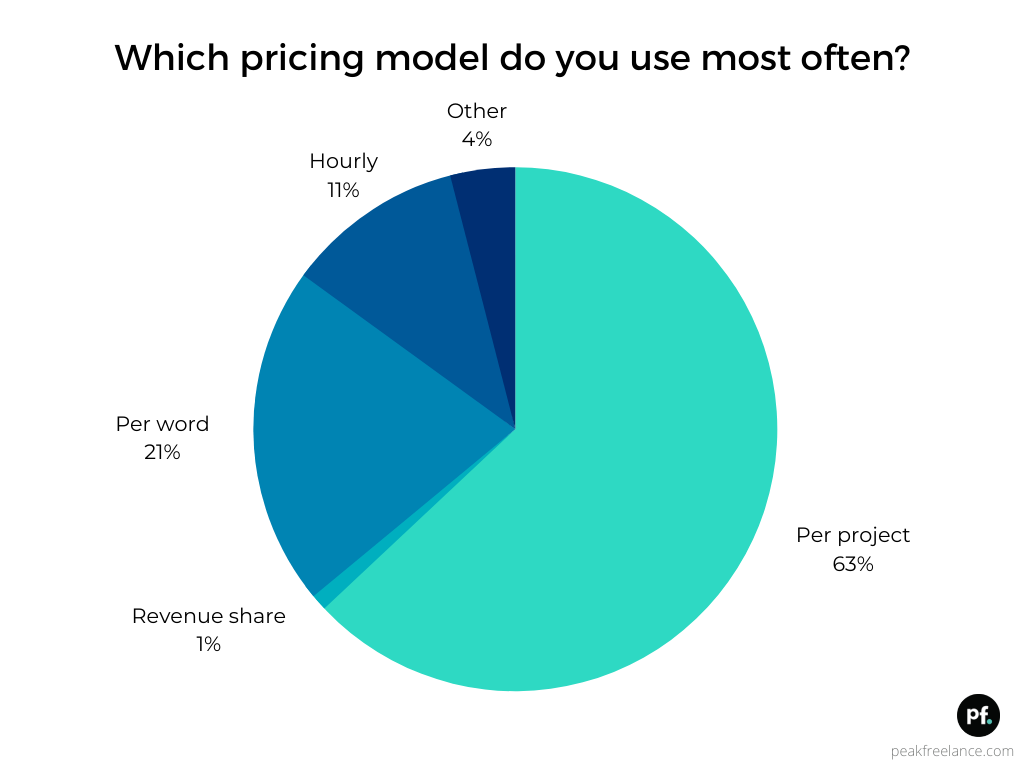
Charging a flat rate per project is the most popular option, no matter how many years of experience writers have—though 84% of those charging by the word are in their first year of business.
It suggests that many agree with this content writer who anonymously said:
“I started with per word pricing but as I gained experience I realized it didn’t truly reflect the work needed to create a high quality post. So I switched to per project rates.”
Wondering why per project pricing comes top? We received lots of comments about the benefits of pricing per project. This respondent sums up what many had to say:
“Per project factors in research, thinking time, writing, editing and procrastination. It’s easier to quote what you’re worth. With per-hour and per-word anything other than the actual writing of the words becomes harder to justify and/or is commonly queried by clients.”
Dealing with revisions and scope creep
Clients asking for revisions is a normal part of writing. It’s highly unlikely that you’ll nail things the first time around. Different clients have different expectations.
We asked our writers how many rounds of revisions they would typically include within their regular rate before charging extra.
Almost all writers (98%) include at least one round of revisions within their standard rate. It’s a fairly even split between those including one round (46%) and two rounds (44%). Some 8% will include three or more rounds within their standard fee.
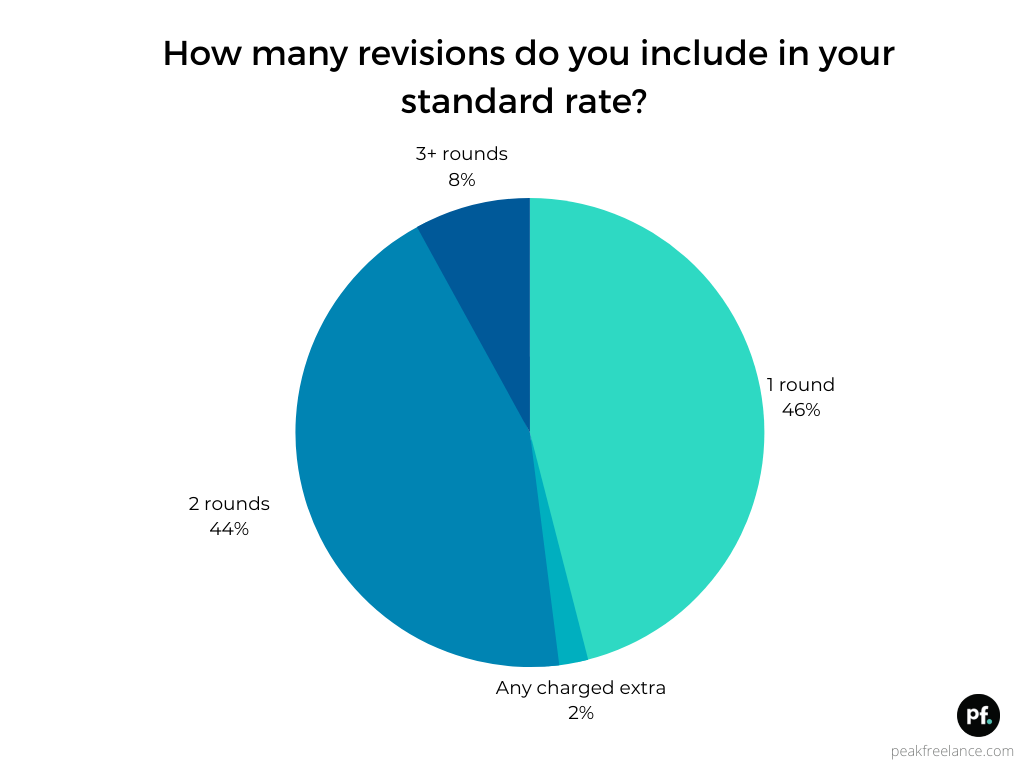
Revisions may be routine, but what do you do if you start work on a project and realize it is far more extensive than expected?
Responses from our writers varied widely on the topic of scope creep. When the situation happens, most writers (44%) would ask the client for an increase in the budget as soon as it becomes clear the work is more considerable. Some 8% would wait until they submitted a draft to ask for an increase.
Worryingly, almost a third would not say anything at all, and absorb the cost of scope creep—likely to avoid the awkward conversation with the client.

There were a lot of comments on this question. Most people tend to make decisions based on the specific circumstances.
Many felt that making an error with quoting would be their fault, so they should be the ones to absorb the costs. But if the project scope had changed, they would review the fee:
“If I’ve misjudged the scope of the project, that’s my fault and I work to the agreed rate. If, however, the client moves the goalposts or adds to the scope after we’ve agreed the fee, I tell them straight away and revise the fee.”
For a lot of freelancers, approaching the difficult conversation of scope creep depends on the relationship they have with the client:
“It all depends on the client. I request a change for long-term clients. For clients I work with sporadically, I tend not to ask for anything additional.”
While many wouldn’t ask for an increase on a current project, they would mention the issue so that clients were aware future projects would cost more.
“If it’s a one off project I’d absorb it at my loss. If there’s potential for an ongoing relationship I’d be honest and say I underquoted on this one, so they’re aware future jobs may cost more.”
Should I show my rates on my website?
Still unsure on whether to show your rates on your website? If you keep them hidden behind email, you’re in good company.
Around three quarters of freelance writers do not display rates on their website.
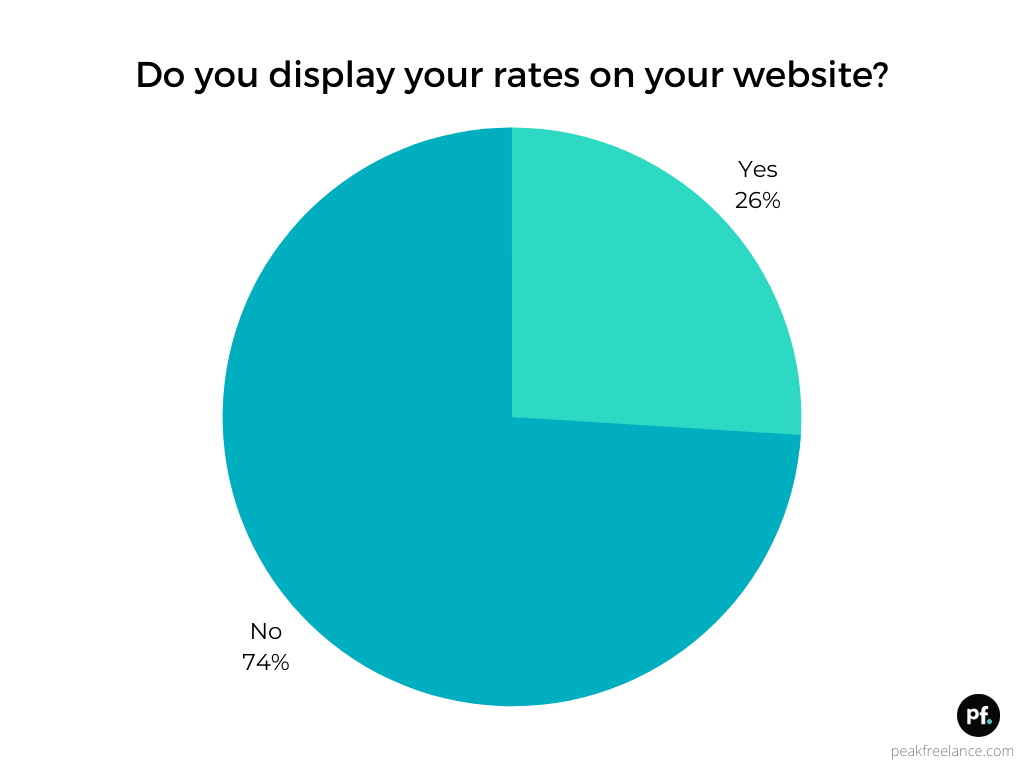
Comments on this topic suggest it is not a straightforward yes or no question. Quite a few writers don’t have a website at all. Many people don’t display detailed rates but do have a “starting from” rate to give potential clients an approximate idea of costs.
“Some clients have a smaller budget. I want to be flexible as much as I can, yet still stay within amounts I’m comfortable with. I know what the lowest rate I am willing to go is, so I want to hear what their budget is before I give a fixed rate. It has allowed me to work with clients and build my portfolio without worry of turning down clients.”
The most common reasons for not displaying rates? Flexibility and having rates that vary significantly between clients.
“I don’t want pricing to scare folks away in case I need to pick up business quickly, or it’s a company I really believe in and would be willing to do work for at a discount. I’d rather folks reach out so I can screen and potentially have the conversation.”
Of those that do display rates on their freelance writing website, the reasons include helping clients make an informed choice and weeding our time wasters.
“Ghosting has become a big problem. Lots of leads and enthusiastic intro calls, but silence as soon as I sent proposals. Publishing guide rates on my site has filtered out the low-end clients, so the ones I end up speaking to know my approximate cost and are more likely to convert.”
Where do freelancers find high-paying gigs?
This one is the million-dollar question, regardless of how long you’ve been freelancing for:
Where do people find lucrative high-paying freelance writing gigs?
Our survey shows the most effective way to get jobs is through referrals and word-of-mouth, with 42% voting it as the channel that drives the highest-paying freelance gigs.
That’s followed by social media (17%), cold pitching (11%), communities (14%) and freelance writing job boards (6%).
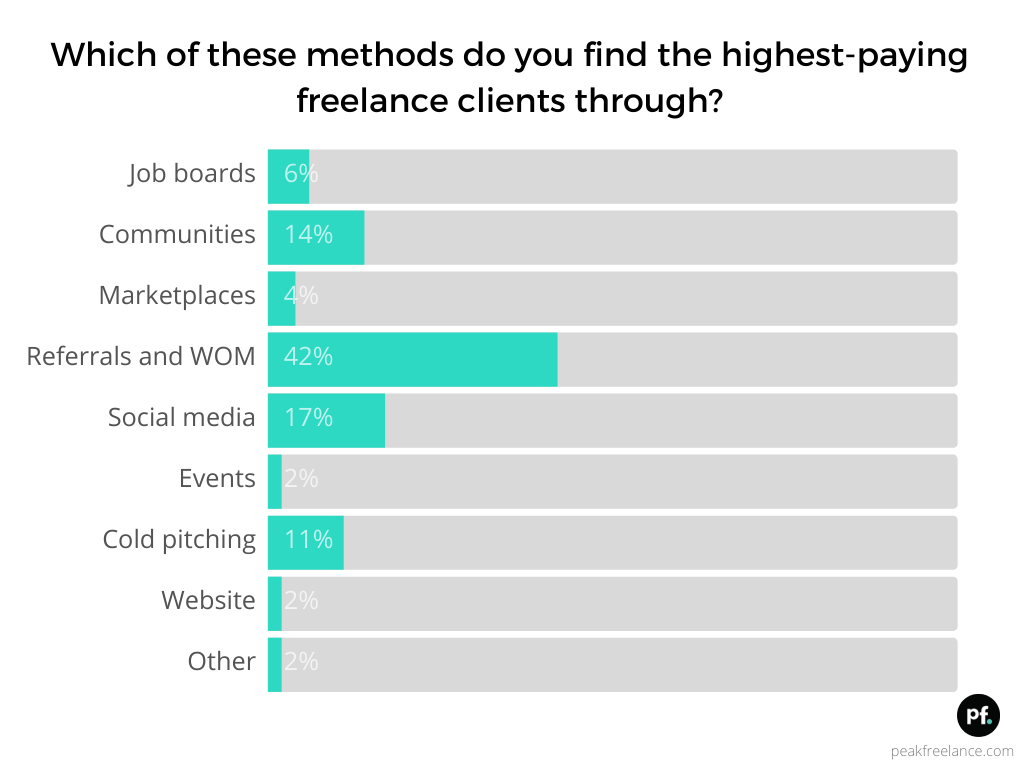
For writers earning six figures, the majority (85%) of their work comes through referrals and word of mouth, compared to just 64% of those earning under $30K finding work in this way. It is clear that making contacts and building relationships can have a huge impact on your career.
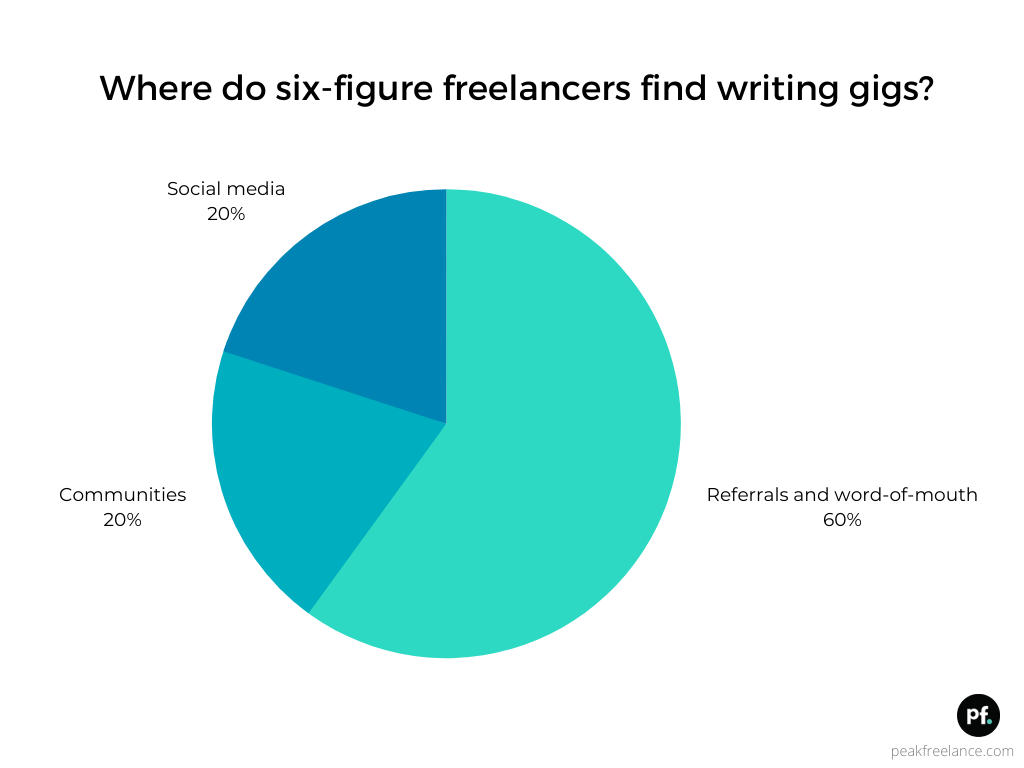
Do your freelance writer rates fall short?
Running this survey has given a fascinating snapshot into how and why writers set their rates as they do.
Charging per project is definitely the most popular pricing method across all levels of experience. It appears to be the method most people move to as they build experience and start increasing their rates.
If you’ve dove into the results of this survey and found your own freelance writing rate falls short, now’s the time to raise them.
Comments suggest people start off very cautiously with their pricing but gradually increase their rates as they gain experience and as they start to see the value they are bringing to clients.
“My first retainer gig with a content agency was $300/post. Using that as a baseline anytime I took on a new client I’ve added 10-20% to my rate, maybe a little more if it’s right in my niche.”
Either way, being upfront about your rates in advance of meeting clients appears to be surprisingly controversial. Many people value the flexibility of being able to vary their rates depending on the client.
There is a strong argument, though, to at least display a ballpark range or “starting from” figure to save wasting time on calls with clients that will never end up working with you.
Ready to scale your freelance writing business?
Peak Freelance is the support group we wish we had when building our freelance writing businesses to six-figures.
Become an All Access member and get access to:
- A private community to make friends and network.
- Expert interviews with content managers and successful freelancers like Kat Boogaard, Kaleigh Moore, and Joel Klettke.
- Monthly Zoom calls with other freelance writers.
- A members podcast sharing unGoogleable freelance writing tips for scaling a business.
- Pro courses, templates, and worksheets to make your business more efficient.
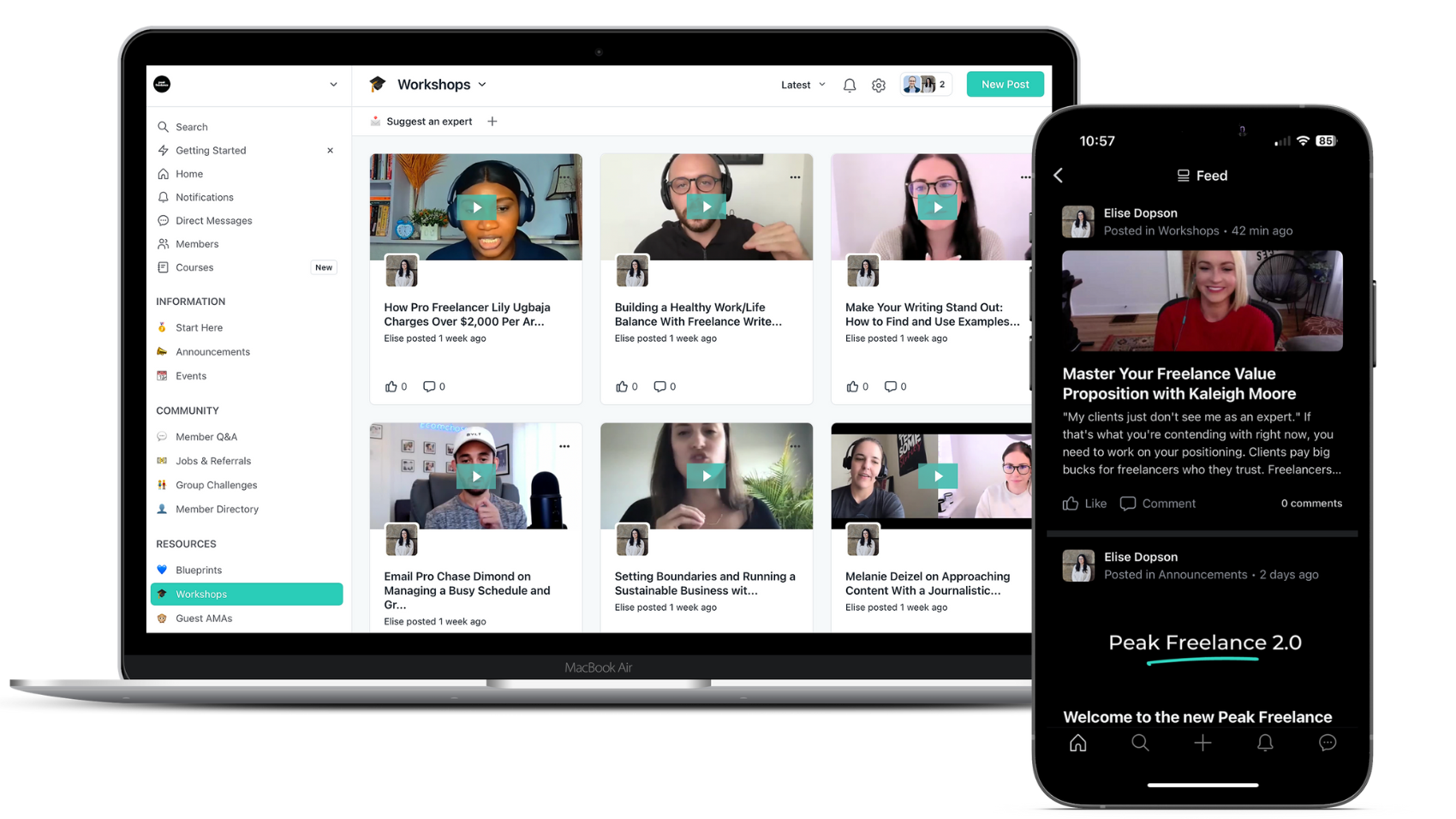
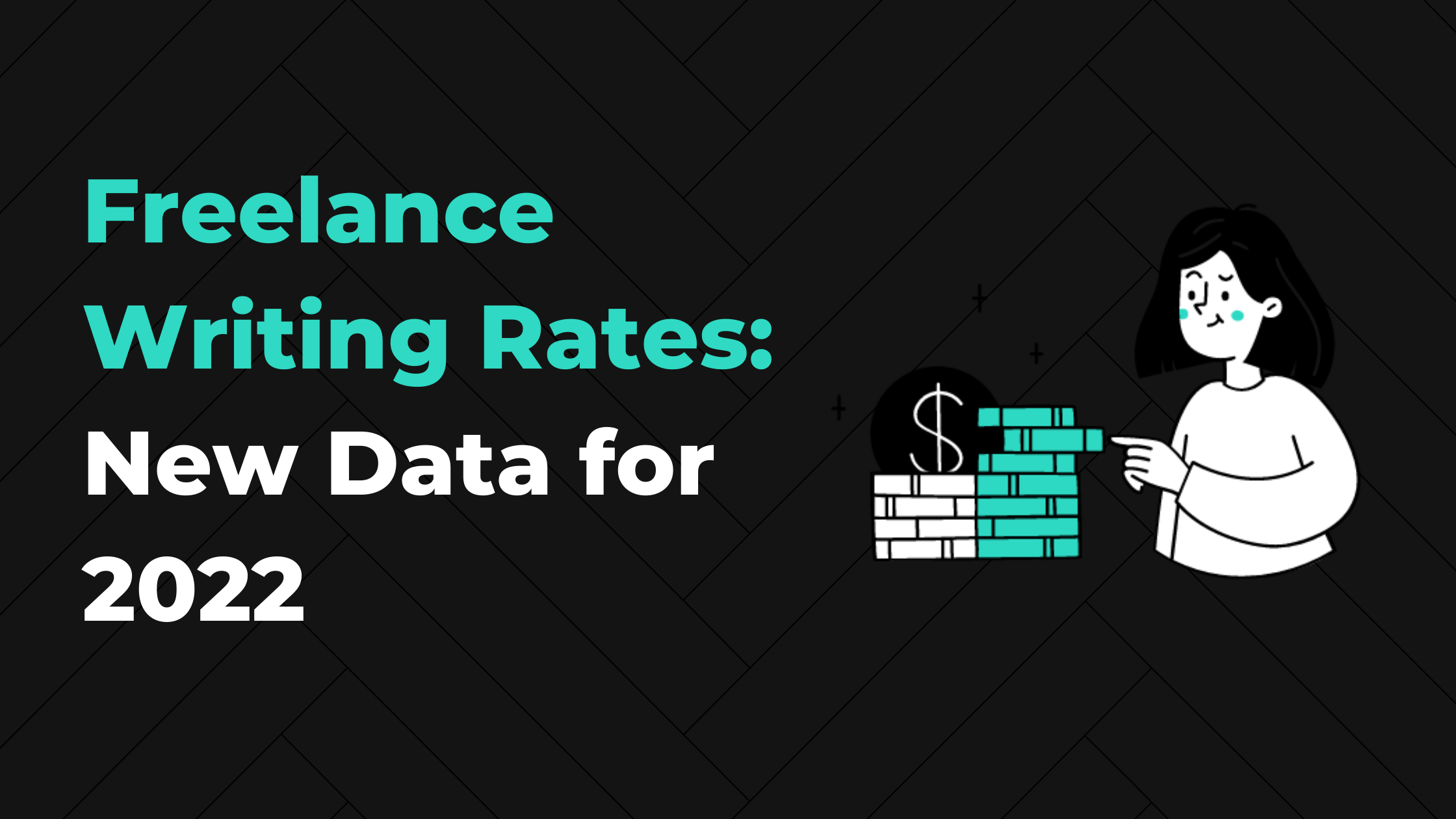
Leave a Reply